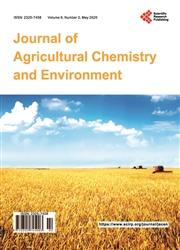Sorption and Desorption Phenomena of Urban Biowaste-Based Heavy Metals by a Ferralsol
引用次数: 0
Abstract
Background: The objective of this study was to examine the adsorption-de- sorption phenomena of heavy metals in an agricultural Ferralsol treated with sewage solid waste at rates usually applied for soil fertility management. Methods: The study was carried out under laboratory conditions, using a Ferralsol sourced from Makerere University Agricultural Research Institute, Kabanyolo (MUARIK). Soil and sewage solid waste were analysed for pH, organic matter, cation exchange capacity and heavy metals (copper, zinc, chromium and lead). Soil was treated with sewage solid waste at input rates of 0, 50, 100, and 150 g per pot (equivalent to 0, 2.5, 5.0 and 7.5 metric tonesm and supplemented with phosphorus. The phosphorus was applied at rates of 0, 0.795, 1.591 and 2.385 g per pot (equivalent to 0, 25, 50 and 75 kg·ha﹣1, respectively). Batch adsorption was used to study the sorption-desorption of heavy metals on the treated soil and the Langmuir and Freundlich models were used to analyse the data. Results: Adsorption and desorption isotherms fitted better to Freundlich equation than Langmuir model. Chromium was the most sorbed and retained metal; while lead was the least retained overall. The desorption process was virtually irreversible, considering the low amounts of the metals desorbed. Chromium fitted relatively better to both models than the copper, zinc and lead. All the four metals were less desorbed at high metal concentrations. Conclusion: The four metals would not be available at high metal concentrations especially when the application rate used is ≥ 5.0 tones·ha﹣1 of the sewage solid waste. Thus, the metals would not be available for plant uptake and the chance to contaminate groundwater is very limited especially for chromium.Ferralsol对城市生活垃圾中重金属的吸附和解吸现象
背景:本研究的目的是检验用污水固体废物处理的农业Ferralsol中重金属的吸附-解吸现象,其速率通常用于土壤肥力管理。方法:本研究在实验室条件下进行,使用来自Makerere大学Kabanyolo农业研究所(MUARIK)的Ferralsol。对土壤和污水固体废物的pH值、有机物、阳离子交换能力和重金属(铜、锌、铬和铅)进行了分析。用污水固体废物处理土壤,每盆投入量分别为0、50、100和150克(相当于0、2.5、5.0和7.5公吨),并补充磷。磷的施用量分别为每盆0、0.795、1.591和2.385克(相当于0、25、50和75公斤)﹣分别为1)。采用分批吸附法研究了重金属在处理土壤上的吸附-解吸过程,并采用Langmuir和Freundlich模型对数据进行了分析。结果:吸附和解吸等温线比Langmuir模型更符合Freundlich方程。铬是吸附和保留最多的金属;而铅总体上保留最少。考虑到解吸的金属量很低,解吸过程几乎是不可逆的。铬比铜、锌和铅更适合这两种型号。所有四种金属在高金属浓度下都较少解吸。结论:这四种金属在高金属浓度下是不可用的,尤其是当使用率≥5.0 tones·ha时﹣污水中的1种固体废物。因此,这些金属将无法用于植物吸收,污染地下水的机会非常有限,尤其是铬。
本文章由计算机程序翻译,如有差异,请以英文原文为准。
求助全文
约1分钟内获得全文
求助全文

 求助内容:
求助内容: 应助结果提醒方式:
应助结果提醒方式:


